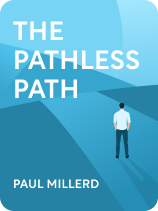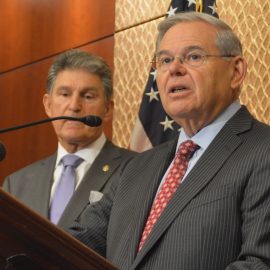

This article is an excerpt from the Shortform book guide to "The Pathless Path" by Paul Millerd. Shortform has the world's best summaries and analyses of books you should be reading.
Like this article? Sign up for a free trial here.
Is the freelancing life for you? What can you learn from others who’ve made the switch?
Like most people, Paul Millerd was taught to place conventional, full-time work at the center of his life—but it made him miserable. Now, he’s a freelance blogger, consultant, career coach, and online course creator—and he’s much more satisfied with his life.
Keep reading to get informed and inspired by Millerd’s story.
Stumbling Upon the Freelancing Life
Millerd explains that most people prioritize work because they believe it’s the best or only path available to them since it affords them security (in the form of a regular paycheck) and respect (in the form of being recognized as a contributing member of society or even one of the elite). People also continue to prioritize work because they’re uncomfortable with change—it’s easier to dread your job every day and live for the weekend or for retirement than it is to try something unconventional in pursuit of a more meaningful life.
(Shortform note: Another reason some people prioritize work over other important parts of life is workaholism—working unreasonably hard or for unreasonably long hours. Experts say workaholism is usually driven by internal factors (as opposed to workplace demands). These include an inability to stop thinking about work even when you’re off duty, a drive to exceed expectations at your job, and a compulsion to overwork. If you’re a workaholic, deprioritizing work may be especially difficult—but since workaholism can negatively impact your relationships and general life satisfaction, it might also be especially beneficial.)
However, during his traditional career, Millerd encountered freelancers—people who are self-employed and contract with companies, doing work only on their own terms. According to Millerd, the freelancers he knew worked less and did things they enjoyed—like traveling and spending time with family—more often. He explains that the freelancing life is a relatively new possibility and that most people don’t realize it exists—if they did realize that it was possible not to prioritize work, they’d be more likely to pursue that alternative. So, he wrote this book to teach people it’s possible to prioritize life enjoyment over work.
(Shortform note: Experts explain that freelancing emerged at the turn of the 21st century and expanded rapidly in the 2010s. While some people only take on freelance projects, others freelance to make extra money while they concurrently work a part-time or even full-time job. Some benefits of freelance work include greater flexibility, better work-life balance, and increased autonomy. However, freelancing also has some drawbacks—for example, you have to assume responsibility for your own accounting needs, and you can’t receive traditional job benefits like retirement plan options.)
Switching to the Freelancing Life
When Millerd’s priorities changed, he knew that he needed to redesign his life around them—and the freelancers he encountered taught him that it was possible to design a life he’d truly enjoy. Now, we’ll explore how he made the switch to freelancing and what effect the switch had on his life.
Millerd’s switch to freelancing was gradual: He remained traditionally employed while he explored other options. During this time, he had a few experiences that solidified his choice to start working for himself.
First, since he didn’t care as much about his job anymore, he started to put less effort into it. He continued planning a traditional career path because he still believed this was the only viable option, but his performance was tanking, and he knew he’d have to leave his job. He thought that moving to another company might solve his problem, but they gave him an unexpectedly low salary offer. He says this made him reevaluate his relationship with money: He realized he didn’t mind making less money if he could also work less and do things he genuinely enjoyed. That wasn’t possible with this job, so he rejected it.
At the same time, he launched a new freelance business as a career coach, something he genuinely cared about and enjoyed. Millerd says the exhilaration he felt as he launched his business stood in stark contrast to the dismay he felt at his regular job. Eventually, he had to admit to himself—and his boss—that he didn’t really want the job anymore.
Finally, Millerd accidentally quit his job—he got into an email dispute with his manager, something he said made his manager think he’d formally quit, and he didn’t care enough about keeping his job to correct him. He had to stay on for three months to train his replacement, and he did so lifelessly. After his last day, he realized he’d been experiencing burnout—a sense of spiritless exhaustion that, he says, happens when your values and definition of success don’t align with those of the organization you work for. He realized that he wasn’t living up to his own expectations and that this was his fault for prioritizing work—so it was time for a change.
With no pressing responsibilities after he quit his job, Millerd booked a five-week vacation to Europe to relax. He explains that he didn’t feel confident about his choices or the future, but he was committed to exploring new options. When he returned to the US, the pressure to make money was back on—his savings were starting to dwindle. He decided to minimize his cost of living and took advantage of every freelance opportunity available to him—mostly consulting work with other companies.
| Should You Transition to Freelancing? Before you jump into a freelance career, you should understand your motivations for doing so. Let’s discuss some of the signs you’re ready—or not ready—to transition. Millerd explains that he started to realize it was time for a career change when he became less engaged at work. Experts define employee engagement as an emotional commitment to your work, and they explain that low engagement may be a sign that your job isn’t a good fit for you. However, if you need to keep your job for the time being, be mindful that low engagement can negatively impact your performance, as it did for Millerd. One way to counteract this is by changing unsatisfying aspects of your job to make it feel more meaningful. Another factor in Millerd’s decision to leave the traditional workforce was his realization that money didn’t matter very much to him anymore. Some research suggests that this was a good call—beyond the $75,000 mark, higher salaries don’t enhance your happiness. However, keep in mind that Millerd had savings to fall back on (enough that he could afford a European vacation and pay bills). If you’re not in a similar financial situation, a steady income might be more important to you than it was to him. In that case, your transition to freelancing may need to be more gradual—and it’s possible freelancing isn’t right for you at all, since freelancing is associated with higher financial insecurity. Millerd says that, when he started working as a freelancer, he knew it was a good choice because it satisfied his passions (whereas his traditional job did not). However, experts note that while having a job you’re passionate about might be good for you, turning your passions into a career can actually decrease the pleasure you take in them. Having a job you’re passionate about can also come with pitfalls like the erosion of work-life boundaries and increased risk of burnout. If you’re thinking about transitioning to a freelance career, it’s worth considering how the pros and cons of following your passions might play out in your life. If you ultimately decide that you do want to start freelancing, you may find it helpful to ensure the transition is gradual. One way to do this is by starting a side hustle (part-time freelance work) while you hold down your regular job, as Millerd did with his career coaching business. Experts note that side hustles are becoming exceedingly common—around 44 million Americans have one. Note that taking on a side hustle in addition to an unsatisfying day job may lead to burnout, since you may overexert yourself or become demoralized if you don’t see positive results quickly enough. To prevent burnout, make sure you’re doing enough self-care (like eating well and sleeping enough). |
How Switching to Freelancing Changed Millerd’s Life
As a freelancer, Millerd experienced total autonomy for the first time—he could work on his own terms, which energized him. However, he realized that he still defined his identity in terms of his career, which prompted him to think about his identity outside of work. He decided to prioritize recreation ahead of work and took a break from relentlessly pursuing freelance opportunities that forced him to work on projects he didn’t truly care about.
(Shortform note: In Drive, Daniel Pink argues that intrinsic motivation (an authentic desire to do something) is what makes work meaningful—which could be why Millerd was energized by the opportunity to choose work projects he was genuinely interested in. Pink also recommends taking a break from work, like Millerd did, if you need to increase your intrinsic motivation—he explains that this gives you a chance to discover and figure out how to pursue what truly matters to you. If you’re having trouble taking a break from work because it’s tied to your identity, the best way to decouple your job and identity is by experimenting with new ideas, exploring new places, and seeking out new experiences outside of work.)
As a result of his choice to prioritize recreation, Millerd had a surge in creativity—he revamped his blog, started a podcast, and eventually started designing his own online consulting courses. This experience taught him that creative work was the only work he really found joy in. (Shortform note: It makes sense that Millerd’s creativity was enhanced when he started spending more time relaxing and having fun—according to experts, rest is foundational to creativity. When you’re relaxed, you’re not focusing on any particular subject; as a result, your subconscious mind can wander, discover new possibilities, and produce creative epiphanies.)
Altogether, Millerd’s early freelancing experiences taught him that he wanted to work just enough to sustain himself and no more than that—he was now fully committed to living life to the fullest by prioritizing recreation, exploration, and joy. He got rid of most of his belongings, moved to Taipei, Taiwan, and embraced a minimalist lifestyle: few possessions and few responsibilities. This enabled him to lower his cost of living so that he could focus on his new priorities.
(Shortform note: If you want to work fewer hours so you can spend more time on recreation, exploration, and joy, you may need to learn how to make the most of your working hours. In Do Nothing, Celeste Headlee recommends maximizing your productivity by working in short bursts with breaks in between, collaborating with others whenever possible, and doing the bare minimum since working too hard might leave you too exhausted to enjoy your free time. Minimalism might also increase your productivity—by reducing the number of possessions and responsibilities that worry or distract you, you increase your ability to focus on your work.)
Millerd also decided that, instead of living for the weekend or waiting for retirement to do what he cared about, he’d incorporate exploration into his regular life by devoting intense energy to a new experience (like learning a new language or traveling) for a short period of time, then resting and moving on. He explains that this is a great way to experiment with what makes you happy—you’re not exhausting yourself by overcommitting, and you gradually figure out what really makes you happy and should be incorporated into your day-to-day life when you do eventually retire.
(Shortform note: In How to Do Nothing, artist Jenny Odell says there’s also some value in exploring the world around you (as opposed to traveling elsewhere). She recommends using your free time to explore three facets of your daily life: the nature that surrounds you, the history of the place where you live, and the people who live near you. According to Odell, exploring these things will make you feel more connected to and appreciative of your community. One benefit of exploring close to home rather than far-off places and cultures is that this is easy to incorporate into your daily life right now, as Millerd suggests you do—you don’t have to wait until you can afford a vacation or retirement.)

———End of Preview———
Like what you just read? Read the rest of the world's best book summary and analysis of Paul Millerd's "The Pathless Path" at Shortform.
Here's what you'll find in our full The Pathless Path summary:
- How to take a non-traditional approach to career success through freelancing
- Why Americans prioritize work and the disadvantages of this lifestyle
- One man's inspiring story of shifting from the workforce to freelancing






